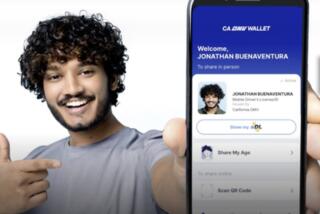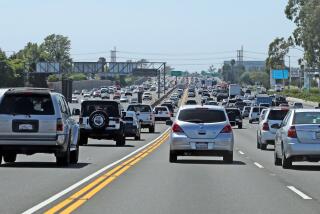Distracted driving: California gets $1.5 million to keep eyes on road
- Share via
WASHINGTON -- The U.S. Department of Transportation, in an effort to highlight the dangers of distracted driving, is sending about $1.5 million to the Sacramento area for advertising and increased police enforcement.
As part of the “Phone in One Hand, Ticket in the Other” campaign, Transportation Secretary Ray LaHood announced this week that the federal government would provide $2.4 million to California and Delaware to initiate pilot programs aimed at examining whether increased police enforcement and paid media advertisements can seriously reduce distracted driving.
“Distracted driving is an epidemic,” LaHood said in a news release Thursday. “While we’ve made progress in the past three years by raising awareness about this risky behavior, the simple fact is people are continuing to be killed and injured -- and we can put an end to it.”
In 2010, at least 3,092 people were killed in distracted-driving accidents, accounting for one in 10 traffic fatalities, according to data from the National Highway Traffic Safety Administration. Cellphone use on its own was a factor in 24% of all crashes in 2010, according to the National Safety Council.
Still, only 39 states currently ban texting and 10 states prohibit hand-held cellphone use behind the wheel.
California prohibits texting and hand-held cellphone use while driving. Yet, 10.8% of California drivers are using cellphones at any given daylight hour, according to observational data from the state Office of Traffic Safety.
“When you talk about drinking and driving, there’s a stigma with that,” said Danielle Lee, Secretary for Teens Against Distracted Driving, a Washington state-based organization that works to inform teens about the dangers of distracted driving. “The same thing hasn’t happened with distracted driving, so people don’t think it’s a big deal. They don’t realize this is something that is really dangerous and killing thousands of people every year.”
California will use its federal money to saturate the Sacramento Valley media market with advertisements and pay for extra officers to patrol solely for distracted driving over two-week periods in December, February or March, and June, said Chris Cochran, spokesman for the Office of Traffic Safety.
“We’re coupling extra officers with a lot of media coverage to let people know distracted driving is dangerous and law enforcement will catch you,” he said.
The California and Delaware pilot programs follow successful smaller-scale programs in Hartford, Conn., and Syracuse, N.Y., in 2011. Those programs led to a 72% decrease in texting in Hartford and a 32% decrease in Syracuse, officials said.
Though Lee applauded the efforts, she said the only sure way to prevent distracted driving would be to create more severe penalties for violators.
“Market saturation and enforcement is a big part of it, but we also need to make the punishments more severe so people understand this isn’t something you can just do, get a ticket and then keep doing it,” she said.
ALSO:
“Car Talk’s” last lap: Click and Clack to retire; fans mourn
Military suicides spike -- nearly 1 per day, Pentagon reports
Arctic Ocean mega-bloom: Scientists’ eyes popped and jaws dropped
More to Read
Sign up for Essential California
The most important California stories and recommendations in your inbox every morning.
You may occasionally receive promotional content from the Los Angeles Times.










